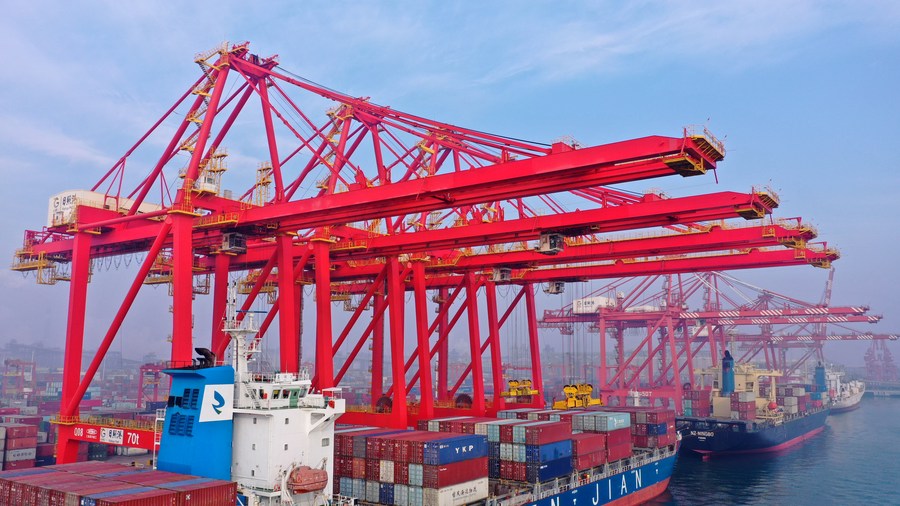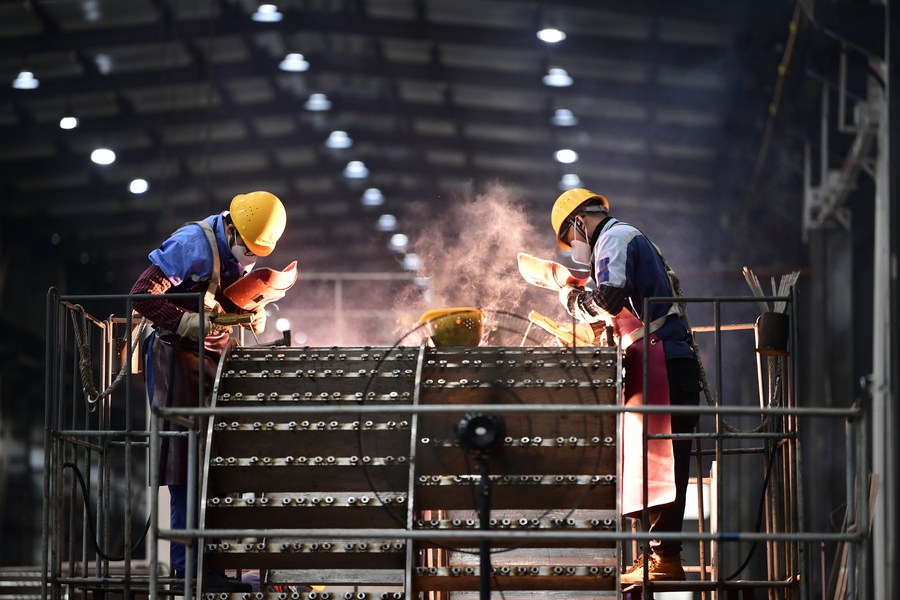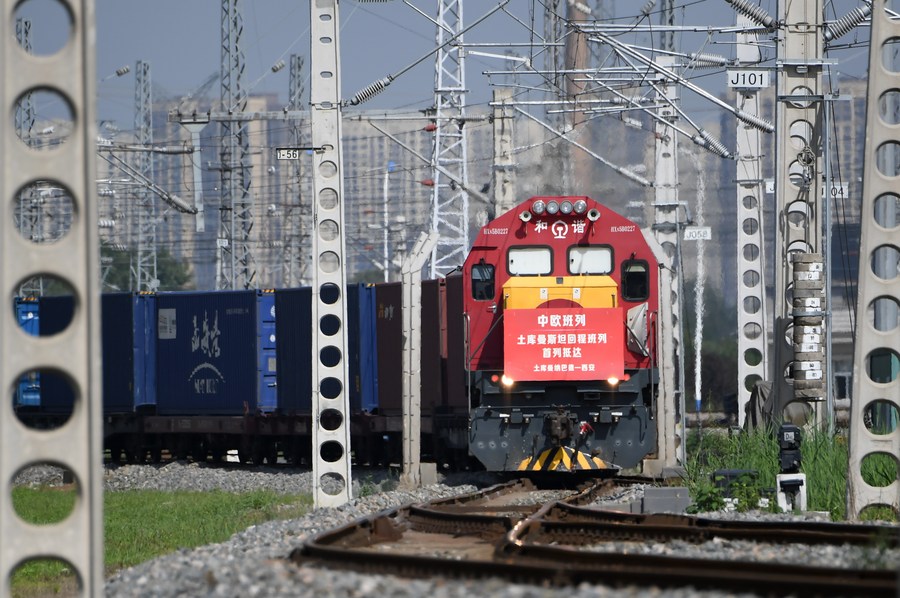Commentary: Why will Chinese economy "genetically" rebound?

Aerial photo taken on Jan. 26, 2022 shows cargo vessels at Rizhao Port in Rizhao, east China's Shandong Province. (Xinhua/Guo Xulei)
- As Joe Ngai, managing partner of McKinsey Greater China, put it: "As global investors and corporations look for growth, everyone is wondering: Where's the next China?"
- "If you are looking for growth, the answer is very simple. The next China is China," he said.
BEIJING, March 1 (Xinhua) -- China's economy grew 3 percent in 2022 despite downward pressures, exceeding 17 trillion U.S. dollars, its National Bureau of Statistics said Tuesday. With that, China leads the world in growth among major economies.
This resilient performance once again echoes what Joerg Wuttke, president of the EU Chamber of Commerce in China, once said: the Chinese economy has a rebound gene.
Since the beginning of this year, the Chinese economy has shown strong recovery and vitality. As international institutions have raised China's growth expectations, multinational companies have increased investment in China, and global commodity prices are also on the way up driven by the rebound of China's domestic demand.
One may wonder why the Chinese economy can always bounce back. Effective policy coordination is among some of the key factors that help make it possible.

Staff members operate at a workshop in a technology equipment company in Ganzhou, east China's Jiangxi Province, Feb. 13, 2023. (Photo by Hu Jiangtao/Xinhua)
Thanks to China's institutional advantages, Beijing is capable of providing elements of stability for the effective operation of the market based on the country's evolving economic landscape.
Vitor Gaspar, director of the Fiscal Affairs Department of the International Monetary Fund, said that China's overall price level is relatively low, and China still has ample policy space.
For example, while China's monetary policy can ensure a reasonably abundant liquidity, it can also roll out supportive policies, like expanding tax and fee incentives to small and micro enterprises, to companies facing financial drought, as well as to green development and technological progress.
Wichai Kinchong Choi, senior vice president of leading Thai bank Kasikornbank, pointed out that China's economy is resilient and its policies to address internal and external challenges are highly coordinated and long-term in nature.
For Andy Rothman, an investment strategist at Matthews Asia, "with Beijing likely to remain the only major government engaged in serious easing of fiscal and monetary policy -- which much of the world is tightening -- China may once again be the engine of global economic growth."
China's robust consumer market is another major factor. The market is underpinned by a population of 1.4 billion, an expanding middle-income group that exceeds 400 million, a set of pro-domestic demand measures, particularly seen with the country's optimized COVID-19 response as well as a high-quality growth strategy that prioritizes innovation.
For the first time since the pandemic, China's consumption growth this year will outpace the country's economic expansion, and consumers are likely to spend more on services as they resume dining out and traveling, said Christine Peng, head of Greater China Consumer Research at Swiss banking giant UBS.

A citizen buys film tickets at a cinema of a shopping mall in Beijing, capital of China, Dec. 25, 2022. (Xinhua/Ren Chao)
In January, Bank of America estimated that Chinese households will unleash 1 trillion yuan (145 billion dollars) of excess savings in 2023.
During China's weeklong Spring Festival holiday that ended on Jan. 27, the revenue of domestic tourism hit 375.8 billion yuan, up 30 percent from the holiday last year, China's Ministry of Culture and Tourism counted.
Coupled with more policies to boost people's spending capacity, better housing, new energy vehicles, elderly care as well as other forms of new consumption demands are going to further unleash consumption potential.
The 2023 McKinsey China Consumer Report identified "a continuously rising middle class" and "premiumization" as trends reshaping China's consumer market this year.
Another factor that makes the Chinese economy different from others is its unique industrial ecology. It features the world's most complete industrial system, a stable and secure supply chain and highly connected infrastructure network, enabling domestic and foreign enterprises in China to enjoy incomparable advantages in cost, efficiency and innovation.
According to statistics, the actual use of foreign investment in China's high-tech industry in 2022 increased 30.9 percent in dollar terms compared with the previous year.
With the strengthening of China's economic recovery, it has become a global strategic choice for more and more multinational companies to strengthen their distribution of supply chain in China.
On Jan. 28, U.S. multinational consumer goods retailer Procter &Gamble (P&G) announced its decision to move the product supply chain from its current base in Europe to south China's Guangdong province.
Not coincidentally, top U.S. electric automaker Tesla Inc. also stated a concrete target to produce around 1.8 million cars in 2023. Apparently, its Gigafactory in Shanghai and other related supporting enterprises are why Tesla can announce such an ambitious goal.
In addition, through its supply-side structural reform and high-quality economic development, China is continuously exploring new models of industrial development. The super-large single market in China and its manufacturing industry chain have paved the way for new technology application, integration and iteration.
Michael Kirsch, president and CEO of Porsche China, said Porsche's presence in China goes far beyond a sales unit, as China is also its innovation powerhouse, helping set important trends with huge influence on the global economy.
Some foreign media, including The Diplomat, have noted that China has made remarkable achievements in electric vehicles, artificial intelligence, digital economy and space technology, and that high-quality development is greatly enhancing innovations and the sustainability of China's economic growth.

A China-Europe freight train arrives at Xi'an international port in Xi'an, northwest China's Shaanxi Province, Aug. 31, 2022. (Xinhua/Li Yibo)
Of course, opening-up is also key to China's economic success.
China continues to promote high-level opening up to the outside world and the full integration of domestic and international markets and resources. That creats new opportunities for countries in their economic cooperation with China.
One year into the implementation of the Regional Comprehensive Economic Partnership, China's foreign trade with other members of the agreement grew by 7.5 percent year-on-year to 12.95 trillion yuan (1.93 trillion dollars) in 2022, statistics from China's General Administration of Customs showed.
This year marks the 10th anniversary of the Belt and Road Initiative. Over the past decade, China has signed cooperation agreements with 151 countries and 32 international organizations, with its trade with countries along the Belt and Road up 19.4 percent in 2022 over the previous year.
"We anticipate that with the reopening of China, there'll be a big recovery of demand among Chinese consumers. Since many countries in the region trade with China, that will benefit their exports to China. It should be beneficial to all the value chains that China is connected to," Albert Park, chief economist of the Asian Development Bank, was cited by media as saying.
Meanwhile, China is also committed to improving its business environment, coordinating its internal and external markets and sharing factors of production and resources more efficiently.
Foreign direct investment (FDI) into the Chinese mainland, in actual use, expanded 14.5 percent year on year to 127.69 billion yuan in January, the Ministry of Commerce said Monday. In U.S. dollar terms, the FDI inflow went up 10 percent year on year to 19.02 billion dollars.
Beneath the data is the policy support for institutional openness. In 2022, China fully implemented the shortened negative list for foreign investment, expanded the encouraged investment catalog, and added more cities to the pilot program of opening the service sector.
As Joe Ngai, managing partner of McKinsey Greater China, put it: "As global investors and corporations look for growth, everyone is wondering: Where's the next China?"
"If you are looking for growth, the answer is very simple. The next China is China," he said.
Photos
Related Stories
Copyright © 2023 People's Daily Online. All Rights Reserved.









